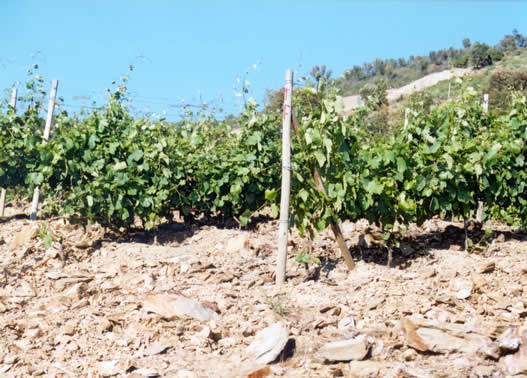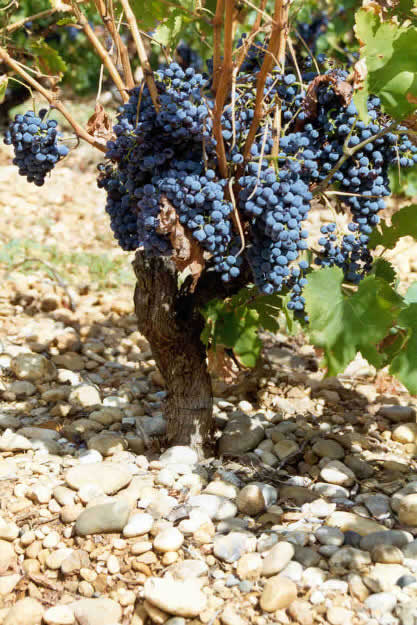|
Mechanisms
of terroir, part 2
 Treating vines mean to keep them keen Treating vines mean to keep them keen
It is helpful to think about
plants as sophisticated environmental computers. Just as we sense the
world around us and then use this information to guide our actions, so
do plants. It’s just that whereas we respond quickly – for
example, if it is too hot in one place we move somewhere cooler –
plants respond over a much longer timescale. Literally rooted to the
spot, they adapt their growth form to best suit the local conditions.
This extends to their reproductive strategies. Generally (and
simplistically) speaking, if conditions are good, then plants opt for
vegetative growth; if they are bad, they choose to reproduce sexually
(the ‘I’m outta here’ option), which means fruit production. So
viticulturalists want to treat their vines mean enough that they focus
on fruit production, while giving them just enough of what they need
so that they don’t suffer from water or mineral deficit, which would
hamper their efforts at producing ripe fruit. Thus many viticultural
interventions aim at encouraging the vine to partition nutrients to
the grapes so that they ripen properly, rather than concentrating on
growing more leaves and stems (vegetative growth or ‘vigour’).
An example of this
‘environmental computing’ is seen in the growth of plant roots.
Root growth is determined by interplay between the developmental
program of the plant and the distribution of mineral nutrients in the
soil. The roots grow to seek out the water and nutrients in the soil:
to do this it appears that they sense where the various nutrients are
and then preferentially send out lateral shoots into these areas. Low
levels of nutrients in the upper layers of the soil results in the
roots growing down to a greater depth, which is likely to improve the
regularity of water supply to the vine.
 ‘Vines have roots which can
reach up to 3 metres in depth’, reports Davidian. ‘These deep
roots can actively take up water and minerals, even though most
mineral ions are more abundant at the root surface.’ ‘Vines have roots which can
reach up to 3 metres in depth’, reports Davidian. ‘These deep
roots can actively take up water and minerals, even though most
mineral ions are more abundant at the root surface.’
A popular notion is that very
old vines with deep roots express terroir better. ‘The claims often
made regarding the importance of deep rooted vines are based on the
assumption that the roots are then able to better exploit the
underlying geology’, says Dawid Saayman. ‘In turn, this is
considered by some to contribute certain minerals and thus impart a
certain character to the wine. There is no scientific proof for
this.’ It’s also worth mentioning here the existence of
mycorrhizae. Many plant roots form an association with specific soil
fungi, where the fungi hitch a ride on the roots, gaining energy from
the plant, while the plant root gains an enhanced absorptive area and
ability to extract mineral nutrients from the soil – this is termed
a ‘mutalistic symbiosis’, because both partners benefit.
Some
people have claimed that mycorrhizae are important for terroir
expression, but this is not clear from the scientific literature.
Dawid Saayman points out, however, that grape vine mycorrhizae mainly
assist in phosphorus uptake, an element that vines usually don’t
have problems getting enough of. ‘It is highly unlikely that
mycorrhizal associations are prominent enough to contribute to a
terroir effect’, he concludes.
How soils have their effect
Soils differ in their chemical
and physical properties. According to Victoria Carey, a lecturer in
viticulture at Stellenbosch University who specializes in terroir, the
latter are more important for terroir effects. ‘The most convincing
indications in the scientific literature are that the effect of soil
type is through its physical properties, and more specifically,
through the water supply to the grapevine,’ she suggests.
This is a
position that Richard Smart agrees with: he cites the pioneering work
of French scientist Gérard Seguin, who conducted a survey of the
properties of the soils in the Bordeaux region. Seguin couldn’t find
any reliable link between the chemical composition of the soil and
wine character or quality, and maintained that it was the drainage
properties of the soil affecting the availability of water that
mattered. He concluded that it is ‘impossible to establish any
correlation between the quality of the wine and the soil content of
any nutritive element, be it potassium, phosphorus or any other
oligoelement.’
The verdict was that it was the physical properties
of the soils, regulating the water supply to the vine, that were all
important in determining wine quality. The best terroirs were the ones
where the soils are free draining, with the water tables high enough
to ensure a regular supply of water to the vine roots which then
recedes on veraison (when the berries change colour) so that
vegetative growth stops and the vine concentrates its energies on
fruit ripening.
The consensus among the
viticulture experts I consulted seems to be that the chemical
composition of the soil – that is, nutrient availability – is only
important when there is excess nitrogen, leading to excess vigour, or
when there is a serious deficiency. ‘Nutrition can be instrumental
to the specific growth pattern of the vine and thus can cause a
specific canopy architecture and therefore ripening pattern,’ says
Dawid Saayman. ‘The plant performance therefore modifies the
vineyard climate creating a specific microclimate in the bunch zone,
and in this way it can greatly determine the character of the wine’,
he adds. ‘Overall, nutrient effects are minimal’, adds Smart.
Soil chemistry effects
But before we give up on soil
chemistry as an important factor in terroir, it’s worth taking a
look at recent research on the effects of mineral nutrition on plant
physiology. I spoke to a number of researchers who are actively
working on plant mineral nutrition, so see whether their work might
shed some light on the mechanisms of terroir transduction.
‘I wouldn't be at all surprised if soil chemistry had an
effect on the expression of genes that are involved in the production
of the compounds that determine flavour,’ says Professor Brian Forde
of Lancaster University (UK). ‘There is certainly plenty of evidence
that plants are tuned to detect and respond to soil nutrients’, he
adds. ‘The balance between the nutrients (nitrogen, phosphorus,
potassium, sulphur and calcium, and even the micronutrients) is
likely to be important and the plant stress responses elicited by
limiting amounts of one nutrient would probably be subtly different
from the stress responses elicited if another nutrient is limiting.'
Forde referred me to some publications showing that the levels of
various plant metabolites were significantly altered under different
nutrient regimes. At a more detailed level, it is now clear that
patterns of gene expression in plants are altered by the presence and
absence of various nutrients.
I spoke to Professor Malcolm
Bennett and Dr Martin Broadley of Nottingham University, who recently
published a paper showing the effects of phosphate deficiency on plant
gene expression. Broadley feels that it won’t be too long before we
have a much better idea about the influence of soils on wine flavour.
‘There is a large amount of work underway to understand the
molecular biology of grapes, and scientists are identifying genes that
influence wine flavour’, he explained. ‘As more grape molecular
biology is known, the easier it will be to understand mechanisms of
terroir on wine taste. When genes encoding for proteins that influence
wine taste are identified, then the effects of different components of
terroir (e.g. the availability of different minerals, soil pH, soil
water content) on specific biochemical pathways can be identified and
tested. This research may allow current agronomical practices to
be improved to enable better-tasting grapes to be produced, or it
might even allow varieties of grapes to be selected or bred more
effectively.’
Concluding remarks
Even if science leaves us with
what currently looks like rather an emasculated version of terroir, I
don’t think that this necessarily diminishes the importance of this
cherished concept. Wine growers who use terroir as their guiding
philosophical framework and focus on the importance of the soil are
responsible for a disproportionately large share of the world’s most
interesting wines. Perhaps Randall Grahm’s wacky rock experiments
aren’t so misguided after all: although it seems clear that there is
no direct link between soils and wine flavour, by framing their
activities within the context of a soil-focused worldview and trying
to get a bit of somewhereness and minerality into their wines,
winegrowers might be vastly increasing their chances of making
interesting wine. And that’s something the world needs more of.
back
to part 1...
Back to top
|
